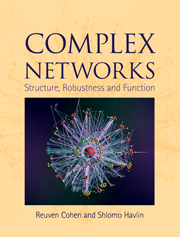Book contents
- Frontmatter
- Contents
- 1 Introduction
- PART I RANDOM NETWORK MODELS
- PART II STRUCTURE AND ROBUSTNESS OF COMPLEX NETWORKS
- PART III NETWORK FUNCTION: DYNAMICS AND APPLICATIONS
- 13 Optimization of the network structure
- 14 Epidemiological models
- 15 Immunization
- 16 Thermodynamic models on networks
- 17 Spectral properties, transport, diffusion and dynamics
- 18 Searching in networks
- 19 Biological networks and network motifs
- Appendix A Probability theoretical methods
- Appendix B Asymptotics and orders of magnitude
- Appendix C Algorithms for network simulation and investigation
- References
- Index
19 - Biological networks and network motifs
from PART III - NETWORK FUNCTION: DYNAMICS AND APPLICATIONS
Published online by Cambridge University Press: 05 August 2013
- Frontmatter
- Contents
- 1 Introduction
- PART I RANDOM NETWORK MODELS
- PART II STRUCTURE AND ROBUSTNESS OF COMPLEX NETWORKS
- PART III NETWORK FUNCTION: DYNAMICS AND APPLICATIONS
- 13 Optimization of the network structure
- 14 Epidemiological models
- 15 Immunization
- 16 Thermodynamic models on networks
- 17 Spectral properties, transport, diffusion and dynamics
- 18 Searching in networks
- 19 Biological networks and network motifs
- Appendix A Probability theoretical methods
- Appendix B Asymptotics and orders of magnitude
- Appendix C Algorithms for network simulation and investigation
- References
- Index
Summary
One of the most important classes of network studied in the literature is biological networks. This class contains a large variety of naturally occurring networks, formed by the long course of evolution. The human (and animal) body contains a large number of networks, some of which occur in real space, such as the networks of blood vessels, the bronchi, and the nerve system. These networks have been studied for a long time, and many of them are known to be fractal objects, see, for example [BH94, BH96, WBE97]. Another class of network, on which we will focus in this chapter, is logical. These are the networks of gene–gene, gene–protein, and protein–protein interactions. A survey of networks in biology can be found, for example, in [BO04].
In the cell, the genetic information is stored in DNA strands sitting in the cell's nucleus. To pronounce the genetic information DNA is transcribed (copied) to messenger RNA by a protein called RNA polymerase. The messenger RNA is then translated by ribosomes, which form amino acids according to the information in the RNA. Every three letter sequence represents a single amino acid from the twenty amino acids existing in humans and most other known organisms. A chain of amino acids is then created from a sequence of letters and forms a protein. The protein folds into a minimal energy configuration, whose shape determines most of its biological function. The created proteins then interact with the genetic information in several ways.
Information
- Type
- Chapter
- Information
- Complex NetworksStructure, Robustness and Function, pp. 200 - 206Publisher: Cambridge University PressPrint publication year: 2010
